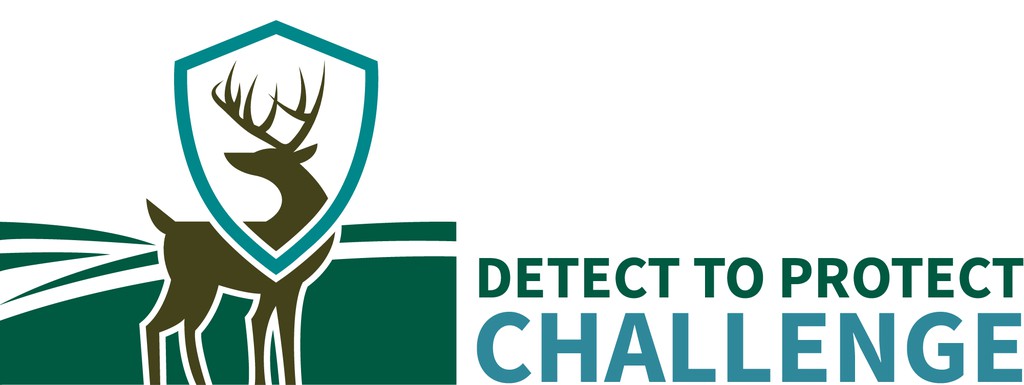
Sensis, on behalf of The United States Department of Agriculture (USDA) Agricultural Research Service (ARS), is hosting the Detect to Protect Challenge: A Live Animal Test for Chronic Wasting Disease (CWD). The challenge invites innovators to submit their idea for a diagnostic test for the early detection of Chronic Wasting Disease (CWD) in a live animal, prior to clinical signs.
Our goal is to inspire the innovative development of a novel diagnostic test that will successfully detect CWD in samples provided by USDA for this challenge. Competitive solutions to this challenge shall consist of novel diagnostic tests that are sensitive and specific for CWD, producing timely and repeatable results on samples easily obtained from live deer. Competitive solutions will also be cost-effective and readily manufacturable. The ideal solutions to this challenge are diagnostic tests that would be eligible for approval as an official Chronic Wasting Disease test by the Administrator of the Animal and Plant Health Inspection Service (APHIS), USDA.
Sensis will award prizes valued up to $170,000. The Detect to Protect Challenge: A Live Animal Test is calling upon innovators and scientists, researchers, and/or startup companies to submit their proposal for developing a novel diagnostic test for the early detection of CWD in a live animal, prior to clinical signs.
Chronic wasting disease (CWD) is a progressive, fatal, neurodegenerative disease of cervids (deer, elk, reindeer, and moose). The infectious agent is a misfolded form of the endogenous prion protein. The normally folded form of the protein is found throughout the body, with the highest concentration in the brain, spinal cord, and lymphoid tissues. With infection, the misfolded form accumulates in the highest concentration in the brain, spinal cord and lymphoid tissues along the alimentary tract. Clinical signs of CWD infection can take years to develop, prior to which animals without clinical signs can still spread disease. Chronic wasting disease belongs to a family of diseases called prion diseases or transmissible spongiform encephalopathies (TSEs). Other TSEs include bovine spongiform encephalopathy (BSE) in cattle, scrapie in sheep and goats, and Creutzfeldt-Jakob disease in humans.
Chronic wasting disease continues to spread in farmed and wild cervids and is of particular concern because the disease can spread at the interface between farmed and wild cervids. CWD is spread through direct animal-to-animal contact via infected body fluids and/or excreta, or indirectly through contact with CWD-contaminated items in the environment, such as soil and other fomites; however, all modes of transmission have yet to be determined.
Today, there are two official postmortem diagnostic tests for CWD surveillance in cervids: Immunohistochemistry and the ELISA test. Immunohistochemistry (considered the gold standard) and the ELISA test both utilize brain and lymph node tissue. The ELISA test is commonly employed by wildlife agencies.
While these two tests are routinely used, they have limited ability to test live animals and cannot be used for samples such as feces, blood, and saliva. CWD has a long incubation period between exposure and clinical signs. Development of an accurate live animal diagnostic assay could allow the detection of disease earlier, limiting direct and indirect transmission.
Our goal is to inspire the innovative development of a novel diagnostic test that will successfully detect CWD in samples provided by USDA for this challenge. Competitive solutions to this challenge shall consist of novel diagnostic tests that are sensitive and specific for CWD, producing timely and repeatable results on samples easily obtained from live deer. Competitive solutions will also be cost-effective and readily manufacturable. The ideal solutions to this challenge are diagnostic tests that would be eligible for approval as an official Chronic Wasting Disease test by the Administrator of the Animal and Plant Health Inspection Service (APHIS), USDA.
The Design Paper phase invites all eligible contestants to submit a concept paper outlining their team’s proposed solution, approach, capabilities, knowledge and skills for this challenge.
Participants’ Design Papers will be reviewed by a panel of subject matter experts who will select up to seven participants for awards. Awardees will receive a) an invitation to Phase 2;
b ) up to $10,000 to assist in developing their rapid tests for Phase 2; and c) USDA-ARS technical resources to enable the development of the test and application for a product license from the Center for Veterinary Biologics, USDA-APHIS.
Review the Official Rules and resources provided on the challenge website. By the May 7 deadline, submit a design paper through the challenge website.
Cover Page and Abstract (1 page)
Project Description (8 pages max; if included, a list of citations is not included in this page limit)
Optional Visual Aid (1-2 pages, 2-3 minutes long)
Design Paper
Design Paper submissions will be evaluated based on the following criteria:
INNOVATION 30%
COST EFFECTIVENESS 20%
FEASIBILITY 50%
Up to 7 Teams Selected to Advance to Phase 2. - $10,000
Awarded to each team to develop their rapid test in Phase 2.
Teams selected to compete in Phase 2 of the challenge will be required to complete the following milestones prior to evaluation:
Milestone 1: Obtain USDA-APHIS Permit Approval
The lab to which the samples will be provided has an USDA-APHIS transport permit that allows for the receiving and handling of prion-infected materials. USDA-ARS and USDA-APHIS will provide information as needed for obtaining a lab permit if a team does not already have a permit. The instructions on how to obtain a lab permit can be found here.
Milestone 2: Successfully Complete Proof-of-Concept with CWD Positive Samples (Proof-of-Concept)
The prototype correctly discriminated between samples obtained from healthy deer and deer with late-stage CWD infection.
Final Evaluation: Submit Coded Samples Test Results
Challenge participants will submit their coded samples test results for final evaluation.
Phase 2 final evaluation will be based on the following criteria:
PRELIMINARY SENSITIVITY AND SPECIFCITYreliminary Sensitivity and Specificity (40%)
TRANSFERABILITY(35%)
REPRODUCIBILITY (25%)
Open to Phase 1 Winners
1st Place - $60,000
2nd Place - $30,000
Optional Prize - $10,000